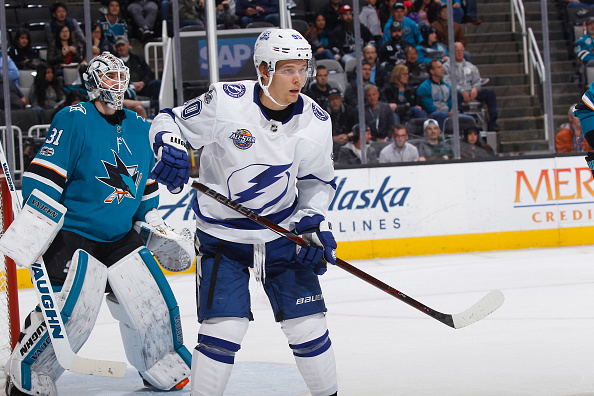NHL player development seems to always result in more questions than answers. How likely is it for a top pick to pan out? What makes a player a “steal”? Last Word On Hockey will be starting a new series on how to properly develop prospects from all different spots throughout the draft. This week’s piece involves draft picks in the back half of the first round and how they were used early in their careers.
NHL Player Development Of First-Round Picks
In the span of 2005 through 2015, there were 84 total selections made between 16th overall and 30th overall on forwards playing in North America. Looking at all 84 forwards, they were split into different categories. Those categories were “Forwards Deemed NHL-Ready and Brought In Immediately When Ready,” “Forwards Near NHL-Ready and Brought In Immediately When Near-Ready,” “Forwards Rushed Slightly,” “Forwards Rushed,” “Forwards Forced,” “A Little Patience,” “Patience,” and “Too Much Patience.”
There were 10 forwards who fell into the fifth category, “a little patience,” on the list. Of those 10 players, five made their NHL impacts in their DY+4 seasons. Those players were Nick Bjugstad, Vladislav Namestnikov, John Quenneville, Brock Nelson, and Sonny Milano. In this piece, we will look at Bjugstad and Namestnikov.
In this piece, we will be using stats from eliteprospects (raw stats) and hockey-reference (ice time). Additionally, the analytics we are using are as follows: even-strength offence goals above replacement (EVO), even-strength defence goals above replacement (EVD), wins above replacement (WAR), and goals above replacement (GAR). Those analytics are from evolving-hockey (subscription required).
NHL Player Development Of Nick Bjugstad
Bjugstad, drafted 19th overall in the 2010 NHL draft by the Florida Panthers, came out of Blaine High School in Minnesota. In his DY-1 season, Bjugstad scored 26 goals and 25 assists for 51 points in 25 games, for 2.04 points per game. That ranked fifth among those aforementioned 84 forwards in DY-1 production. The following season, Bjugstad posted 29 goals and 31 assists for 60 points in 25 games, for 2.4 points per game. That ranked third among those same 84 forwards in DY production. After being drafted, Bjugstad would make the move to the NCAA for three seasons before making the move to the NHL.
In his freshman season at the NCAA with the University of Minnesota, he scored eight goals and 12 assists for 20 points in 29 games, for 0.69 points per game. That ranked 68th among the 82 forwards still outside the NHL in DY+1 production. As a sophomore, Bjugstad scored 25 goals and 17 assists for 42 points in 40 games, for 1.05 points per game. That ranked 30th amongst the 70 forwards still outside the NHL in DY+2 production. In his final season with Minnesota, he scored 21 goals and 15 assists for 36 points in 40 games, for 0.9 points per game. That ranked seventh out of the 46 forwards still outside the NHL in DY+3 production.
How Bjugstad Was Used
Following his NCAA career, Bjugstad would make the leap to professional hockey. He would play exclusively up at the NHL level, playing in 76 games and averaging a strong 16:13 time on ice per game. With that role, Bjugstad scored 16 goals and 22 assists for 38 points, a strong production line. Analytically, he was great offensively, but a liability defensively. To prove it, he had a 7.1 EVO, but a -4.6 EVD. That horrible EVD led his WAR (0) and GAR (-0.2) to be at or below replacement level.
In his second season, he again would play solely at the NHL level, getting into 72 games and averaging 16:35 per game. With a role that was very similar to his rookie year, he scored 24 goals and 19 assists for 43 points. That’s a step up offensively. His EVO (2.5) got worse, but his EVD (-1.6) was much, much better. His WAR (0.4) and GAR (2.1) both improved, thanks in large part to Bjugstad’s power play impact in his second season.
Bjugstad Takes Step Back In Year Three
In his third season, Bjugstad would again be a mainstay at the NHL. Playing in 67 games, he scored 15 goals and 19 assists for 34 points. That was while averaging 15:31 per game, a new low to this point in his NHL career. His EVO (-0.3) took another step back, while his EVD (0) finally was not below replacement level. The continued improvement defensively and the power play effectiveness displayed in year two returned, allowing his WAR (0.5) and GAR (2.8) to become new highs.
After that third season in 2015-16, Bjugstad would play another two and a half seasons with the Panthers. In that span, he played 168 games, scoring 31 goals and 44 assists for 75 points. Being traded in the 2018-19 season to the Pittsburgh Penguins, Bjugstad would play a combined 45 games across that season and a small part of the 2019-20 season. In those games, he scored 16 points. In 2020-21, Bjugstad joined the Minnesota Wild and played two seasons. He scored 30 points in 101 games with the Wild in that time. This season, Bjugstad has played for the Arizona Coyotes. He has scored four points across 12 games thus far.
NHL Player Development Of Vladislav Namestnikov
Namestnikov, drafted 27th overall by the Tampa Bay Lightning in the 2011 NHL draft, came out of the London Knights organization in the OHL. However, in his DY-1 season, he was still in Russia. Playing in the VHL, Namestnikov scored 13 goals and nine assists for 22 points in 33 games, for 0.667 points per game. That ranked 50th out of the 84 forwards in DY-1 production. In his first season with London in the OHL, he scored 30 goals and 38 assists for 68 points in 68 games, for exactly one point per game. That ranked 57th out of those same 84 forwards in DY production.
After getting drafted, Namestnikov would spend one more season in the OHL and two seasons in the AHL before getting an extended look in the NHL. In his final OHL season, Namestnikov scored 22 goals and 49 assists for 71 points in 63 games, for 1.127 points per game. That ranked 39th among the 82 forwards still outside the NHL in DY+1 production. Making the jump to the AHL with the Syracuse Crunch, he scored seven goals and 14 assists for 21 points in 44 games, for 0.477 points per game. That ranked 65th out of the 70 forwards still outside the NHL in DY+2 production. Finally, in his last season before his extended NHL chance, Namestnikov scored 19 goals and 29 assists for 48 points in 56 games, for 0.857 points per game. That ranked eighth out of the 46 forwards still outside the NHL in DY+3 production.
How Namestnikov Was Used
Namestnikov, finally, got his first extended NHL look in his DY+4 season. However, he still would see some AHL games. Playing with the Crunch for 34 games, he scored 14 goals and 21 assists for 35 points, a very strong production line. That earned him a 43-game stint in the NHL, where he averaged 12:00 per game. In that role, he scored nine goals and seven assists for 16 points, a decent stat line. Analytically, Namestnikov was about as good as his raw stats showed. They weren’t great, but they also weren’t bad. His EVO (1.0) was okay, and his EVD (-0.7) was not bad for a rookie, but still below replacement level. With those even-strength numbers, Namestnikov’s WAR (0) and GAR (-0.2) were basically replacement-level.
In his second season, Namestnikov would play exclusively at the NHL level. Across 80 games, he averaged 14:07 per game, over two minutes more than his rookie year per game. In that role, he scored 14 goals and 21 assists for 35 points, another decent stat line. Analytically, however, he took massive strides. His EVO (8.6) was really strong, and his EVD (4.0) was impressive. With the greatly improved even-strength metrics, his WAR (2.1) and GAR (10.1) were very impressive. Namestnikov flashed his promise in his second season.
Namestnikov Remains Solid In Year Three
In his third season, he once again would play exclusively at the NHL level. Getting into 74 games, Namestnikov averaged 14:47 per game. In that role, he scored 10 goals and 18 assists for 28 points, yet another decent production line. Analytically, he would take a small step back but remained solid. His EVO (5.0) and EVD (1.2) took the biggest steps back, but again, they were still solid. Meanwhile, his WAR (1.3) and GAR (6.8) both took only small steps back.
Following those first three NHL seasons, Namestnikov would play just one final season with the Lightning (2017-18). He would be traded at the deadline that year. He scored 44 points in the 62 games before being dealt to the New York Rangers. Namestnikov would play parts of three seasons with the Rangers (2017-18, 2018-19, 2019-20) totalling 99 games played, and scoring 35 points. Namestnikov would play for three teams in the 19-20 season. Those teams were the Rangers, Ottawa Senators (54 games, 25 points), and Colorado Avalanche (nine games, six points).
Namestnikov joined the Detroit Red Wings and played there for two seasons, before being dealt once again in the 2021-22 season. With the Red Wings, he totaled 113 games played and scored 42 points. He was dealt to the Dallas Stars towards the end of the 21-22 season. He played 15 games, scoring five points. This season, he re-joined the Lightning and has so far scored three points in 13 games. The NHL player development of Namestnikov is hard to judge. He has been moved so often, that he hasn’t had a chance to settle in and truly develop fully. But, he has turned out fairly well despite that.
Junior league stats via Elite Prospects, NHL stats via Hockey Reference, NHL analytics via Evolving Hockey
Main photo:
Embed from Getty Images






